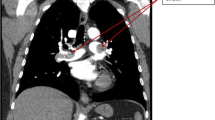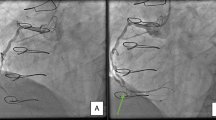Summary
Heparin-induced thrombocytopenia type II (HIT-II) is a serious complication in heparin treatment. Because of arterial and/or venous thromboembolism, HIT-II quite often takes a life-threatening course. This article describes the clinical course of seven trauma patients, who developed HIT-II during thromboembolism prophylaxis with unfractionated heparin (UFH, Heparin-Natrium-Nattermann, 250,000 I. E., Rhone-Poulenc Rorer GmbH), given subcutaneously. Thromboembolic complications occurred in 5 out of 7 cases (71.4 %). One case took a fatal course (14.3 %). UFH was replaced by Orgaran when HIT-II was suspected or diagnosed. There were no more complications. Thrombocyte count increased to normal values within 3 to 9 days. The importance of HIT-II in heparin therapy during in- and outpatient therapy is discussed with reference to the current literature.
Zusammenfassung
Die Heparin-induzierte Thrombozytopenie Typ II (HIT-II) ist eine ernstzunehmende Komplikation einer Heparin-Therapie. Nicht selten kann sie durch venöse und/oder arterielle thromboembolische Komplikationen einen lebensbedrohlichen Verlauf nehmen. Dieser Artikel beschreibt den Verlauf von 7 unfallchirurgischen Patienten, die im Rahmen einer subkutanen Thromboseprophylaxe mit unfraktioniertem Heparin (UFH, Heparin-Natrium-Nattermann 250 000 I. E., Rhone-Poulenc Rorer GmbH) eine HIT-II entwickelten. In 5 der 7 Fälle traten thromboembolische Komplikationen auf (71,4 %), wovon 1 Fall tödlich verlief (14,3 %). Nach Diagnosestellung bzw. Verdacht auf das Vorliegen einer HIT-II wurde die Heparin-Therapie abgesetzt und die Antikoagulation mit Orgaran fortgesetzt. Der weitere Verlauf war komplikationslos, die Thrombozytenwerte stiegen innerhalb von 3–9 Tagen auf Normalwerte an. Nach Umstellung des Prophylaxeregimes auf niedermolekulares Heparin (Mono Embolex® NM, Norartis Pharma) traten keine Thrombozytopenien mehr auf. Die Bedeutung der HIT-II im Rahmen einer Heparin-Therapie im stationären bzw. ambulanten Therapiemanagement wird anhand der gegenwärtigen Literatur diskutiert.
Similar content being viewed by others
Author information
Authors and Affiliations
Rights and permissions
About this article
Cite this article
Kuhn, B. Heparin-assosciated thrombocytopenia – a serious complication during heparin treatment. Clinical course of seven trauma patients. Unfallchirurg 100, 646–651 (1997). https://doi.org/10.1007/s001130050170
Issue Date:
DOI: https://doi.org/10.1007/s001130050170




